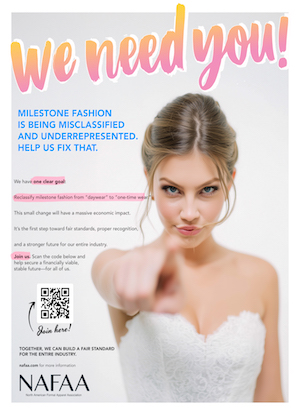Cautiously optimistic.
That’s the sentiment from boutiques and brands reporting on the opening of the Bridal and Prom season in the U.S. in late December/January, as the number of engagements and brides-to-be appears to rival that of this past year, and Prom traffic and store activity points to another very robust season.
Cautious in the sense that:
– Weather in certain regions in the U.S. continues to stall a full opening;
– Boutiques are keeping a wary eye on the projected but slow-moving recession and its potential impact on brides’ and prom girls’ budgets;
– Staffing issues continue to plague boutiques, increasing stress levels on existing staff to deliver the level of customer service the boutique may be known for, and that the bride/prom customer expects;
– Brands facing lengthening delivery schedules for specials (primarily in bridal), continued increases in cost of goods, and instability in shipping fees and schedules.
Optimistic in the sense that:
– Brides and prom girls continue to stay focused on their life stage events. . . with Prom, events they were denied as juniors take on even more importance as seniors. And for engaged couples, the desire to showcase and celebrate their wedding without outside-imposed limitations;
– Brides and teens continue to have spending power and resources, and are increasingly willing to make purchases based on their shopping experience and reputation of boutique and brand;
– Bridal and prom are recession resistant (as suggested in a previous column), proven by a review of the The U.S. Great Recession of 2008 indicating only a minor decrease in the numbers of weddings and virtually no impact on prom numbers;
– As categories, Bridal and Prom are also more impacted by local conditions, circumstances and economies than those on the national level.
Essentially more shoppers and buyers in both categories, with both segments anticipating and appreciating the special, out-of-the-ordinary shopping and buying experience offered only by a specialty boutique.. an experience noteworthy pre-Covid, and significantly more so post-Covid.
The not-so-good news: the exhausting effort necessary to satisfy an increasingly demanding customer undergoing deeper and more complicated levels of stress all the while struggling with staffing issues.





